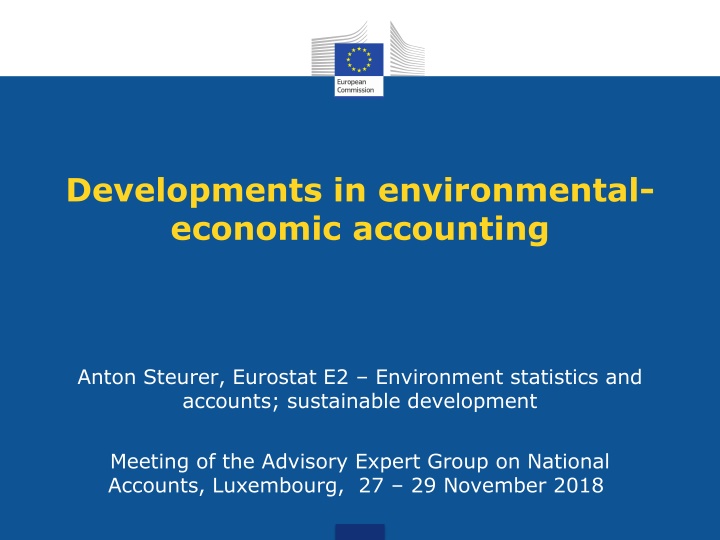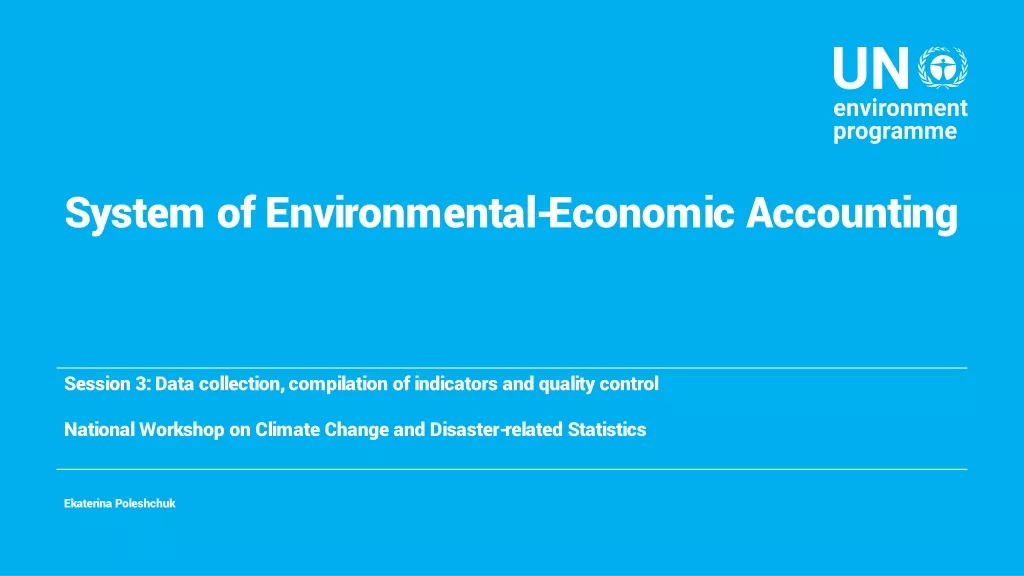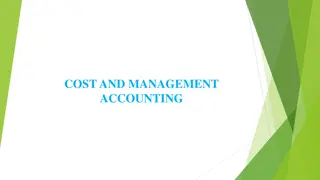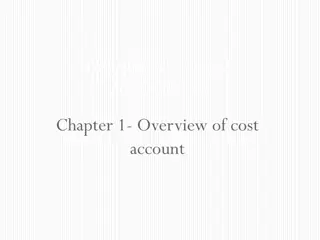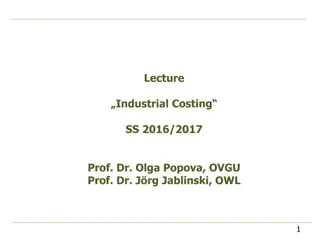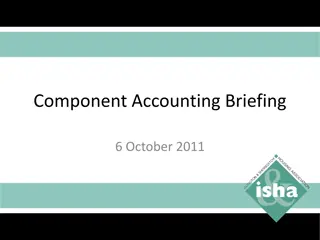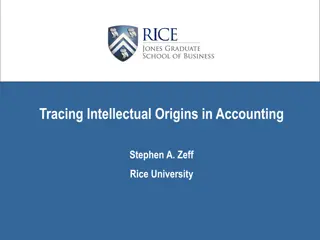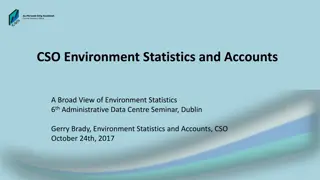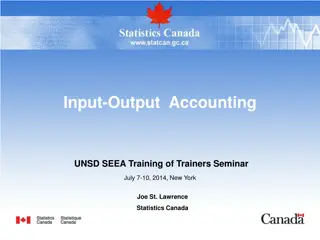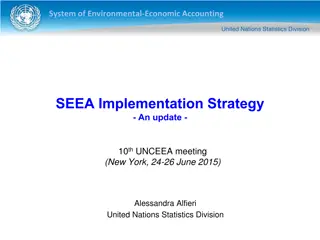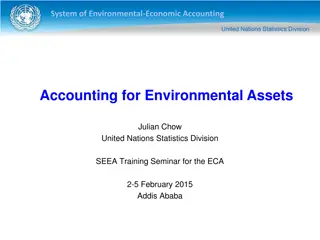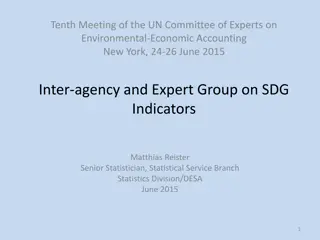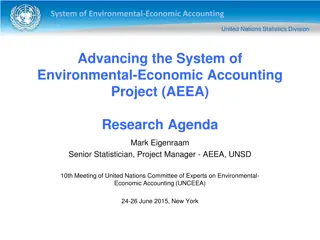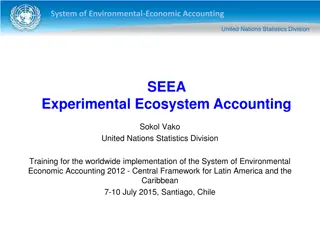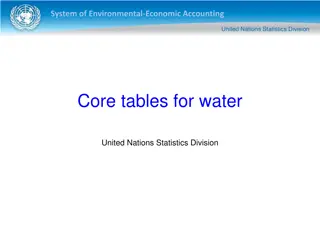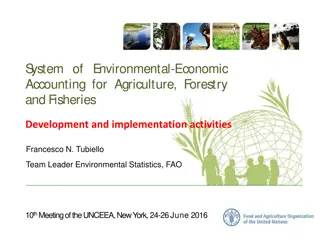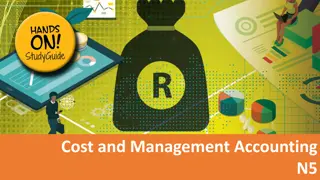Developments in Environmental-Economic Accounting
This content discusses developments in environmental-economic accounting, including integrating environmental information with national accounts, research agendas, international guidance, and the state of play in environmental accounting. Various frameworks and concepts are explored to analyze environmental effects of economic activities and policy measures, aiming for sustainable development and effective monitoring using indicators.
Download Presentation

Please find below an Image/Link to download the presentation.
The content on the website is provided AS IS for your information and personal use only. It may not be sold, licensed, or shared on other websites without obtaining consent from the author.If you encounter any issues during the download, it is possible that the publisher has removed the file from their server.
You are allowed to download the files provided on this website for personal or commercial use, subject to the condition that they are used lawfully. All files are the property of their respective owners.
The content on the website is provided AS IS for your information and personal use only. It may not be sold, licensed, or shared on other websites without obtaining consent from the author.
E N D
Presentation Transcript
Developments in environmental- economic accounting Anton Steurer, Eurostat E2 Environment statistics and accounts; sustainable development Meeting of the Advisory Expert Group on National Accounts, Luxembourg, 27 29 November 2018
Overview of presentation Introduction to environmental-economic accounting and the SEEA CF and SEEA EEA handbooks Research agenda items of relevance for environmental accounting 2 Eurostat
What is environmental-economic accounting? Presents environmental information in a way compatible with national accounts using the same concepts and classifications Integrates existing data into a coherent system Permits analysis and modelling of environmental effects of economic activities and policy measures Basic frameworks supply-use tables (what goes in comes out) and balance sheets (opening stock plus change gives closing stock) Main areas: Physical flow accounts (air emission, energy ) Monetary accounts (taxes, environmental outlays ) Asset accounts (physical and monetary) New area: ecosystem accounting 3 Eurostat
Environmental accounting: international guidance United Nations, European Commission, FAO, IMF, OECD and World Bank (2013): System of Environmental-Economic Accounting 2012 Central Framework (International Statistical Standard) = SEEA CF https://seea.un.org/sites/seea.un.org/files/seea_cf_final_en.pdf United Nations, European Commission, FAO, OECD and World Bank (2014): System of Environmental-Economic Accounting 2012 - Experimental Ecosystem Accounting = SEEA EEA https://seea.un.org/sites/seea.un.org/files/seea_cf_final_en.pdf United Nations: Technical Recommendations in support of the System of Environmental- Economic Accounting 2012 Experimental Ecosystem Accounting 2017 Several other 4
Environmental accounting: State of play Research agendas exist for both SEEA CF and SEEA EEA SEEA EEA revision process ongoing with planned completion at the en of 2020 Global DSDs are being established for key environmental accounts Use of indicators from environmental accounts for SDG monitoring increases Several meetings in the next 2 years linked to the revision of the SEEA EEA could be put to use for strengthening the link to the SNA research agenda 5
Research agenda items of particular relevance for environmental accounting SEEA CF and SEEA EEA SEEA1 - Development of consistent valuation techniques SEEA2 - Depletion of natural biological resources SEEA3 - Losses SEEA5 - Ecosystem services SEEA4 - Fossil fuel subsidies by industry as part of climate statistics Many other items have an impact on EA 6 Eurostat
Research agenda items of particular relevance for environmental accounting (cont.) SNA research agenda draft SNA28 - Tradable emission permits SNA29 - Leases to use or exploit natural resources SNA35 - Valuation of natural resources GFS research agenda (GFS11 = SNA35) GFS2 - Application of re-routing GFS3 - Terminal costs 7 Eurostat
Losses key issues There are a number of issues related to losses which are not yet fully described in the SEEA CF. These include losses of natural gas, electric energy and water. Papers were drafted during the drafting of the SEEA CF which should be reviewed for better clarification of the terminology and conceptual issues and how to address them. Example: physical losses (and hence unit prices) depend on number of units separate units for production and distribution mean higher recorded losses (and higher intermediate consumption) 8 Eurostat
Fossil fuel subsidies Important Tier 3 SDG indicator (tier 3 = in need of definition). Data available at the International Energy Agency and OECD. IEA uses price-gap method. Data used by IMF include calculations of external costs. Connecting these data sets to SEEA should be possible. Issues: links to consumer subsidies, treatment of tax differentials as transfers and re-routing. 9 Eurostat
Depletion of biological resources More challenging than non-renewable as they proper management can make them recover. Depletion in physical terms to come from SEEA. Issues: asses valuation using net present value approaches. Institutional setting. 10 Eurostat
Ecosystems and ecosystem services Topic of SEEA EEA. Services of ecosystems include provisioning (e.g. crop production), maintenance (e.g. flood protection) and cultural services (e.g. recreation). Some ecosystem services are captured by the SNA (e.g. the contribution of ecosystems to crop or timber or fish production or some parts of recreational services in rentals or in tourism), others not (cleaner air, parts of recreation ). Issues: production boundary, many valuation challenges relevant for SNA incl. consistency and institutional assumptions, issues of ownership. 11 Eurostat
Components of ecosystem accounting Current focus 12 Eurostat
Households producing energy re-routing Increasingly, buildings are equipped with installations to e.g. capture solar heat and to generate photovoltaic electricity. In Europe support measures have different setups, ranging from a legally requiring electricity companies to pay high feed-in tariffs, to direct taxes and subsidies. While economic reality is similar, the recorded transactions are not. Issues: imputing forced transactions, production boundary. 13 Eurostat
Many other areas of interest All other items under Economic well-being and sustainability are relevant in an ecosystem accounting context. Also SNA44 on leasing, SNA10 on the concept of income, SNA 19 on income from assets, SNA5 on output of government, SNA32 on maintenance and capital repairs, SNA24 on provisions and more widely SNA1 on the link to IASB. An issue to note is the discussion on treatment of restoration costs and liabilities especially in the context of leases that might be a specific area for discussion. 14 Eurostat
Environmental accounting key dates (tentative) where links to SNA could be discussed 22-24 Jan 2019 valuation of ecosystem services meeting in NY April or June 2019 Forum of Experts on ecosystem accounting in NY June 2019 UN Committee of experts on environmental accounting (UNCEEA) in NY Oct 2019 London Group on environmental accounting in Canberra 15
Thank you! Eurostat
